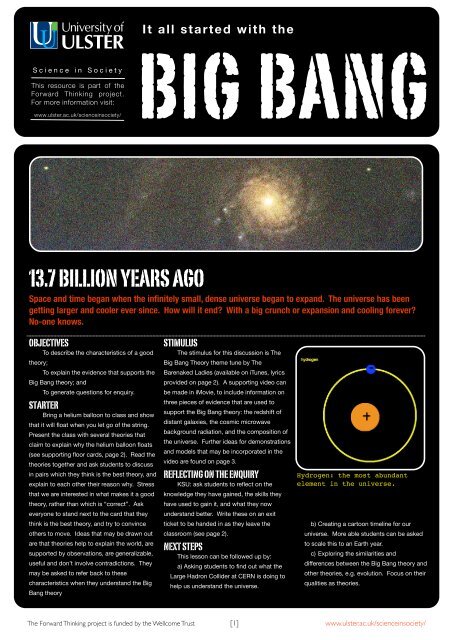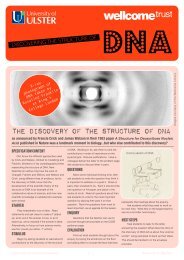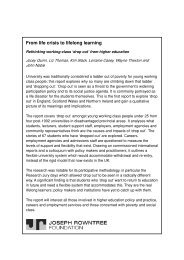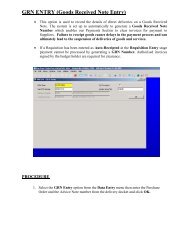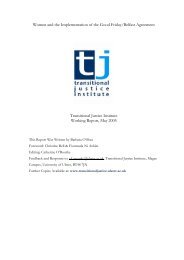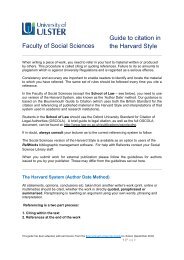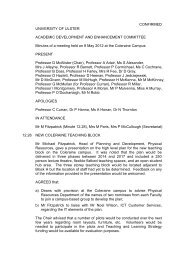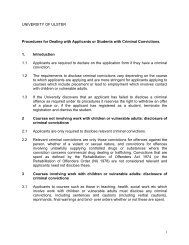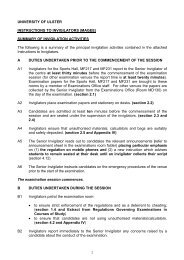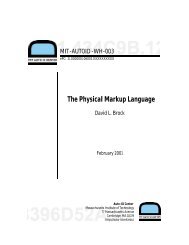It all started with the big bang - University of Ulster
It all started with the big bang - University of Ulster
It all started with the big bang - University of Ulster
Create successful ePaper yourself
Turn your PDF publications into a flip-book with our unique Google optimized e-Paper software.
Science in Society<br />
This resource is part <strong>of</strong> <strong>the</strong><br />
Forward Thinking project.<br />
For more information visit:<br />
www.ulster.ac.uk/scienceinsociety/<br />
<strong>It</strong> <strong>all</strong> <strong>started</strong> <strong>with</strong> <strong>the</strong><br />
BIG BANG<br />
13.7 BILLION YEARS AGO<br />
Space and time began when <strong>the</strong> infinitely sm<strong>all</strong>, dense universe began to expand. The universe has been<br />
getting larger and cooler ever since. How will it end? With a <strong>big</strong> crunch or expansion and cooling forever?<br />
No-one knows.<br />
OBJECTIVES<br />
To describe <strong>the</strong> characteristics <strong>of</strong> a good<br />
<strong>the</strong>ory;<br />
To explain <strong>the</strong> evidence that supports <strong>the</strong><br />
Big Bang <strong>the</strong>ory; and<br />
To generate questions for enquiry.<br />
STARTER<br />
Bring a helium b<strong>all</strong>oon to class and show<br />
that it will float when you let go <strong>of</strong> <strong>the</strong> string.<br />
Present <strong>the</strong> class <strong>with</strong> several <strong>the</strong>ories that<br />
claim to explain why <strong>the</strong> helium b<strong>all</strong>oon floats<br />
(see supporting floor cards, page 2). Read <strong>the</strong><br />
<strong>the</strong>ories toge<strong>the</strong>r and ask students to discuss<br />
in pairs which <strong>the</strong>y think is <strong>the</strong> best <strong>the</strong>ory, and<br />
explain to each o<strong>the</strong>r <strong>the</strong>ir reason why. Stress<br />
that we are interested in what makes it a good<br />
<strong>the</strong>ory, ra<strong>the</strong>r than which is “correct”. Ask<br />
everyone to stand next to <strong>the</strong> card that <strong>the</strong>y<br />
think is <strong>the</strong> best <strong>the</strong>ory, and try to convince<br />
o<strong>the</strong>rs to move. Ideas that may be drawn out<br />
are that <strong>the</strong>ories help to explain <strong>the</strong> world, are<br />
supported by observations, are generalizable,<br />
useful and don’t involve contradictions. They<br />
may be asked to refer back to <strong>the</strong>se<br />
characteristics when <strong>the</strong>y understand <strong>the</strong> Big<br />
Bang <strong>the</strong>ory<br />
STIMULUS<br />
The stimulus for this discussion is The<br />
Big Bang Theory <strong>the</strong>me tune by The<br />
Barenaked Ladies (available on iTunes, lyrics<br />
provided on page 2). A supporting video can<br />
be made in iMovie, to include information on<br />
three pieces <strong>of</strong> evidence that are used to<br />
support <strong>the</strong> Big Bang <strong>the</strong>ory: <strong>the</strong> redshift <strong>of</strong><br />
distant galaxies, <strong>the</strong> cosmic microwave<br />
background radiation, and <strong>the</strong> composition <strong>of</strong><br />
<strong>the</strong> universe. Fur<strong>the</strong>r ideas for demonstrations<br />
and models that may be incorporated in <strong>the</strong><br />
video are found on page 3.<br />
REFLECTING ON THE ENQUIRY<br />
KSU: ask students to reflect on <strong>the</strong><br />
knowledge <strong>the</strong>y have gained, <strong>the</strong> skills <strong>the</strong>y<br />
have used to gain it, and what <strong>the</strong>y now<br />
understand better. Write <strong>the</strong>se on an exit<br />
ticket to be handed in as <strong>the</strong>y leave <strong>the</strong><br />
classroom (see page 2).<br />
NEXT STEPS<br />
This lesson can be followed up by:<br />
a) Asking students to find out what <strong>the</strong><br />
Large Hadron Collider at CERN is doing to<br />
help us understand <strong>the</strong> universe.<br />
Hydrogen: <strong>the</strong> most abundant<br />
element in <strong>the</strong> universe.<br />
b) Creating a cartoon timeline for our<br />
universe. More able students can be asked<br />
to scale this to an Earth year.<br />
c) Exploring <strong>the</strong> similarities and<br />
differences between <strong>the</strong> Big Bang <strong>the</strong>ory and<br />
o<strong>the</strong>r <strong>the</strong>ories, e.g. evolution. Focus on <strong>the</strong>ir<br />
qualities as <strong>the</strong>ories.<br />
The Forward Thinking project is funded by <strong>the</strong> Wellcome Trust [1] www.ulster.ac.uk/scienceinsociety/
Print <strong>the</strong> cards below, or copy <strong>the</strong>m on to A4 pages. Place<br />
<strong>the</strong>m on <strong>the</strong> floor and ask students to stand beside <strong>the</strong> card<br />
that represents <strong>the</strong> best <strong>the</strong>ory.<br />
Some birthday b<strong>all</strong>oons float in <strong>the</strong> air. Here are six <strong>the</strong>ories to explain why<br />
<strong>the</strong>y float. Which is <strong>the</strong> best <strong>the</strong>ory and why? <strong>It</strong> does not matter if you do<br />
not know which <strong>the</strong>ory is correct!<br />
The foil on <strong>the</strong>se<br />
b<strong>all</strong>oons is a metal.<br />
This metal is<br />
magnetic<strong>all</strong>y attracted<br />
to <strong>the</strong> sun.<br />
These b<strong>all</strong>oons are<br />
special.<br />
These b<strong>all</strong>oons have a<br />
property c<strong>all</strong>ed levity.<br />
Anything that contains<br />
“levity” floats.<br />
Exit Ticket<br />
Knowledge I have<br />
gained<br />
The b<strong>all</strong>oons are less<br />
dense than air. Less<br />
dense objects float in<br />
more dense fluids.<br />
There is a force<br />
produced in <strong>the</strong><br />
ribbon that acts to<br />
push <strong>the</strong> b<strong>all</strong>oon up.<br />
The b<strong>all</strong>oons are<br />
sprinkled <strong>with</strong> magic<br />
dust.<br />
Skills I have used What I understand<br />
better<br />
Something I still want to know...<br />
BIG BANG THEORY<br />
Barenaked Ladies<br />
Our whole universe was in a hot<br />
dense state,<br />
Then nearly fourteen billion years<br />
ago expansion <strong>started</strong>. Wait...<br />
The Earth began to cool,<br />
The autotrophs began to drool,<br />
Neanderthals developed tools,<br />
We built a w<strong>all</strong> (we built <strong>the</strong><br />
pyramids),<br />
Math, science, history, unraveling<br />
<strong>the</strong> mysteries,<br />
That <strong>all</strong> <strong>started</strong> <strong>with</strong> <strong>the</strong> <strong>big</strong> <strong>bang</strong>!<br />
Since <strong>the</strong> dawn <strong>of</strong> man is re<strong>all</strong>y<br />
not that long,<br />
As every galaxy was formed in<br />
less time than it takes to sing<br />
this song.<br />
A fraction <strong>of</strong> a second and <strong>the</strong><br />
elements were made.<br />
The bipeds stood up straight,<br />
The dinosaurs <strong>all</strong> met <strong>the</strong>ir fate,<br />
They tried to leap but <strong>the</strong>y were<br />
late and <strong>the</strong>y <strong>all</strong> died (<strong>the</strong>y froze<br />
<strong>the</strong>ir asses <strong>of</strong>f)<br />
The oceans and pangea<br />
See ya, wouldn't wanna be ya<br />
Set in motion by <strong>the</strong> same <strong>big</strong><br />
<strong>bang</strong>!<br />
<strong>It</strong> <strong>all</strong> <strong>started</strong> <strong>with</strong> <strong>the</strong> <strong>big</strong> <strong>bang</strong>!<br />
<strong>It</strong>'s expanding ever outward but<br />
one day<br />
<strong>It</strong> will cause <strong>the</strong> stars to go <strong>the</strong><br />
o<strong>the</strong>r way,<br />
Collapsing ever inward, we won't<br />
be here, it wont be hurt<br />
Our best and brightest figure that<br />
it'll make an even <strong>big</strong>ger <strong>bang</strong>!<br />
Australopi<strong>the</strong>cus would re<strong>all</strong>y<br />
have been sick <strong>of</strong> us<br />
Debating out while here <strong>the</strong>y're<br />
catching deer (we're catching<br />
viruses)<br />
Religion or astronomy, Encarta,<br />
Deuteronomy<br />
<strong>It</strong> <strong>all</strong> <strong>started</strong> <strong>with</strong> <strong>the</strong> <strong>big</strong> <strong>bang</strong>!<br />
Music and mythology, Einstein<br />
and astrology<br />
<strong>It</strong> <strong>all</strong> <strong>started</strong> <strong>with</strong> <strong>the</strong> <strong>big</strong> <strong>bang</strong>!<br />
<strong>It</strong> <strong>all</strong> <strong>started</strong> <strong>with</strong> <strong>the</strong> <strong>big</strong> BANG!<br />
The Forward Thinking project is funded by <strong>the</strong> Wellcome Trust [2] www.ulster.ac.uk/scienceinsociety/
Red light ➙<br />
longer waves<br />
EVIDENCE FOR THE BIG BANG<br />
Visit <strong>the</strong> online Big Bang Time Machine at<br />
http://resources.schoolscience.co.uk/PPARC/<strong>bang</strong>/<strong>bang</strong>.htm<br />
1<br />
1<br />
When we look at <strong>all</strong> <strong>the</strong> colours <strong>of</strong> light coming from<br />
stars like <strong>the</strong> sun, we notice that some colours are<br />
missing, and in <strong>the</strong>ir place are dark “absorption<br />
lines.” These colours are missing because atoms in <strong>the</strong><br />
star are absorbing <strong>the</strong>se colours. Atoms <strong>of</strong> different elements<br />
absorb different colours (or wavelengths <strong>of</strong> light), so we can tell<br />
which elements are present in a star from <strong>the</strong> position <strong>of</strong> <strong>the</strong><br />
lines. They look a bit like a bar code.<br />
However, when we look at <strong>the</strong>se “bar codes” <strong>of</strong> distant<br />
galaxies, we see <strong>the</strong> same pattern <strong>of</strong> lines, but shifted towards<br />
<strong>the</strong> red end <strong>of</strong> <strong>the</strong> spectrum. This is an example <strong>of</strong> <strong>the</strong> Doppler<br />
shift (<strong>the</strong> same effect that causes ambulance sirens to change<br />
pitch as <strong>the</strong>y pass).<br />
absorption lines from distant star: red-shifted<br />
Red shift <strong>of</strong> light from<br />
distant galaxies<br />
This can be modeled by drawing<br />
Blue light ➙<br />
shorter waves<br />
a wave on a long, thick<br />
elastic band or length<br />
<strong>of</strong> latex and asking<br />
one student to<br />
represent an<br />
observer on Earth<br />
(holding one end<br />
<strong>of</strong> <strong>the</strong> band) and<br />
ano<strong>the</strong>r to<br />
represent a distant<br />
galaxy. As <strong>the</strong>y move apart (to demonstrate <strong>the</strong> expansion <strong>of</strong><br />
space), students can see that <strong>the</strong> waves get longer, i.e. are red<br />
shifted. Students can <strong>the</strong>n identify <strong>the</strong> limitations <strong>of</strong> <strong>the</strong> model.<br />
The cosmic microwave background radiation was<br />
discovered when two scientists (Penzias and Wilson)<br />
were trying to get rid <strong>of</strong> interference to satellite<br />
broadcasts. They detected microwaves from <strong>all</strong> areas <strong>of</strong><br />
<strong>the</strong> sky, <strong>with</strong> a temperature <strong>of</strong> 2.7K (we can see this interference<br />
as <strong>the</strong> snow pattern on untuned televisions). This discovery<br />
supported <strong>the</strong> <strong>the</strong>ory <strong>of</strong> <strong>the</strong> Big Bang, which could account for<br />
<strong>the</strong>se microwaves as energy left over from <strong>the</strong> Big Bang.<br />
A third piece <strong>of</strong> evidence to support <strong>the</strong> Big Bang<br />
<strong>the</strong>ory is <strong>the</strong> composition <strong>of</strong> <strong>the</strong> universe. The Big<br />
Bang <strong>the</strong>ory predicts that in <strong>the</strong> first few minutes <strong>of</strong><br />
<strong>the</strong> universe, only <strong>the</strong> lightest elements, hydrogen and<br />
helium, were formed. This is consistent <strong>with</strong> what we observe<br />
today: <strong>the</strong> universe is mainly hydrogen (about 73%) and helium<br />
(25%), <strong>with</strong> heavier elements created in stars and in supernova<br />
explosions since <strong>the</strong> Big Bang.<br />
However, a mystery remains. Between 90 - 99% <strong>of</strong> <strong>the</strong><br />
universe is unknown but scientists are currently looking for this<br />
“dark matter” and “dark energy”.<br />
The Forward Thinking project is funded by <strong>the</strong> Wellcome Trust [3] www.ulster.ac.uk/scienceinsociety/<br />
2<br />
3<br />
2<br />
The Cosmic Microwave<br />
Background Radiation<br />
The composition<br />
<strong>of</strong> <strong>the</strong> universe<br />
3


